|
TRADERS OF THE LOST ART
Collecting Pre-Columbian Artifacts of Mesoamerica and Central America
By Syl Turner
Posted January 2012
The subject of collecting Pre-Columbian artifacts is wide-ranging, and the term Pre-Columbian encompasses all of the indigenous peoples of the Caribbean, North, Central and South America prior to the arrival of Columbus. Completely independent of Old World influences, many of these cultures were highly developed and sophisticated. In fact, the peoples of Mesoamerica developed the first great cities of North America.
Pre-Columbian art embraces a wide range of cultures and artistic expression. However, this article will focus only on Mesoamerica (Mexico, Belize and Guatemala) and Central America, and the more commonly found antiquities that are affordable to the average collector.
Although Western art often overshadows the art objects produced by the native Pre-Columbian Indians, great strides have been made in the last 30 years in archaeology and the study of the Pre-Columbian world. This has led to a greater appreciation and interest in the antiquities from this region. Indeed, the ongoing excavations and discoveries give collecting Pre-Columbian art a special sense of wonder and excitement.
Serious, scientific-based archaeology did not begin in many of the Pre-Columbian sites until the 1950s after centuries of foraging and treasure hunting had taken place. Actually, it was not until 1970 with the enactment of the UNESCO treaty that the exportation of excavated pre-Columbian items was prohibited, and this law did not go into effect in the United States until 1983. Simply put, only artifacts that have been in the country since 1983 are legal for purchase by collectors.
Pre-Columbian civilizations in Mesoamerica and Central America are classified into three time periods:
Pre-Classic Period: 1500 BC to AD 300
Classic Period: 300 AD to 900 AD
Post Classic Period: 900 AD to 1540 AD
The more popular and sought-after antiquities in Mesoamerica come from Mexico, and the most desirable items in Central America comes from present day Costa Rica. Although the Mexican cultures did produce articles in jade and stone, their terra cotta art is more common and affordable. In fact, it wasn’t too many decades ago that in some parts of Mexico Pre-Columbian terra cotta figurines turned up in open fields in what seemed like every shovelful of dirt. This suggests that these effigies were “sown,” or ritually buried, in corn fields as an offering to the gods for an abundant crop. Not so long ago, these unique works of art could be purchased for a pittance.
In central Mexico, the Zacatenco culture flourished during the middle Pre-Classic Period, and their art can often be identified by their terra cotta figurines of women. The figurines are normally about three to four inches high, usually depicting young women with small breasts, large hips and large legs. These effigies are almost always of naked women, except for some type of headdress. No doubt such figurines represented their idea of female beauty.
In far western Mexico, the region now comprising parts of Colima, Jalisco and Nayarit, the cultures off the late Pre-Classic period buried their dead in shaft tombs with vaulted chambers. These indigenous people filled these tombs with small hand-modeled clay effigies of gods, animals and miscellaneous replicas of daily life. Much of the pottery and terra cotta figures found in museums and collections today were buried with their original owners, only to be found thousands of years later by coincidence or by amateur treasure hunters.
One cannot write about Pre-Columbian Mesoamerica without mentioning the Olmec culture. The Olmecs invented writing and the calendar in Mesoamerica. The Olmecs are difficult to define geographically as well as chronologically. Some traces of this culture have been found throughout Mesoamerica; however, the heartland of the Olmec culture appears to be on the gulf side of Central Mexico, and historians generally place their prominence as being in the transition period between the Pre-Classic and Classic periods. The Olmecs worked a lot in stone, and the recurrence of certain symbolic images on their carved stone effigies might indicate their belief in magical or supernatural rituals. The image of a stylized jaguar, for example, appears regularly in their art. The most dramatic achievements of the Olmecs were the building of monumental basalt sculptures and colossal heads. Archaeologists believe these massive heads are likely Olmec kings.
Of all the ancient cultures of Pre-Columbia America, the Mayan is considered the most brilliant. The Mayans had the only known, fully-developed written language of Pre-Columbia America. In addition, the Mayans were known for there art, architecture, and mathematic and astronomical systems. Their culture also extended over large parts of Mesoamerica, including the Yucatan and beyond the limits of Mexico to Belize, Guatemala, Honduras and El Salvador. This culture extended into the Post Classic Period and thrived until the late 17th century.
The absence of a potter’s wheel gave all of these Pre-Columbian artisans the freedom to invent and experiment with structure and form, which makes their art so charming. One of the most delightful of all Pre-Columbian terra cotta art is the whistle. Once dismissed as toys, Pre-Columbian whistles are now seen as ancient American wind instruments that were vital to the life of the Mayan people, including the ruling elite. (Recently in Belize, a rich load of instruments was unearthed from a royal tomb, underscoring their importance.) The art of musical instrument making flourished throughout Mesoamerica and Central America until the Spanish conquest. The earliest pre-Columbian clay instruments, found on the present coast of Ecuador, date from approximately 500 BC.
Some of the most popular and highly collectible Pre-Columbian art comes from Costa Rica in the form of personal adornments carved from jade and other stones. The earliest evidence of carved jade in Central America dates to around 500 BC, and artisans continued to produce jade pendants and other ornaments until approximately 700 AD when gold, which was plentiful and easier to work with, became the fashion of choice. Nevertheless, in the eyes of most Pre-Columbians, jade was considered the most precious of all materials. Jade is extremely hard and was very difficult to carve, given the tools available at the time.
One of the most common and most collectible jade carvings is the so-called axe god pendant. The term axe god comes from the shape of the pendant, which is in the form of a traditional chopping tool (celt/axe), with the top of the tool worked into a stylistic bird head and torso. Circular eyes with a large beak sitting above folded wings define the typical avian (bird) axe god. Holes were drilled in the head-torso area to allow the object to be suspended around one’s neck. Human figures were also carved on the axe god pendants, but those were less common.
Most of the jade and stone ornamentation found in museums and private collections today were buried and found thousands of years later, by coincidence or by tomb foragers. It was not until 1973 that Costa Rica made a dedicated effort to conserve the past with intensive archeological excavations and the purchase of artifacts from private collectors.
The market for Pre-Columbian art is rising, and as with any collectible, values are based on supply and demand. An authentic, small terra cotta piece might be purchased for as little as $50, and at the other end of the scale, some gold pieces have sold for more than $1 million. As a general rule, a very attractive 6-inch Colima hollow terra cotta figurine of a female might sell for $200, while a similar 24-inch figure might go for as much as $3,000. A jade axe god pendant can sell for as much as $20,000, depending on its size and the color and clarity of the jade, as well as the overall beauty of the piece. Many jade axe god pendants are available for as little as $1,000. Axe god pendants made of a stone other than jade can range in price from $350 to $2,500.
Pre-Columbian artifacts can be purchased from major auction houses, galleries and established dealers. When buying from a dealer, one should research his or her reputation and longevity. The dealer should guarantee what they sell and like major auction houses, provide a full refund if the buyer can document that the piece is not as it was advertised.
In purchasing these antiquities, recognize that they may be thousands of years old, and the norm is that they have been buried. Thus, they may be chipped or broken and repaired. Repairs are acceptable, and a professional restorer can make repairs that are difficult to recognize. Buyers should examine objects they are purchasing very carefully, knowing that although repairs are acceptable, refurbished items have a lesser value.
------------------------------
Syl Turner is the owner of Broad Street Antique Mall.
Editor’s note: The antiquities pictured are part of an important collection of Pre-Columbian art that was assembled by an astute collector who traveled extensively throughout Mexico and Central America in the 1950s and 1960s. The collection was passed from generation to generation within the family and was recently sold to the owners of the Broad Street Antique Mall in Chamblee, Ga. The entire collection of 200+ pieces is on display there and can be viewed from 10 am to 5:30 pm, Monday-Saturday, and between 1 pm and 5:30 pm on Sundays. The Broad Street Antique Mall is at 3550 Broad St., 1.5 miles inside I-285 off Peachtree Industrial Blvd in the heart of Chamblee’s Antique Row.
|
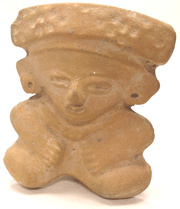
Mayan terracotta whistle male figure, 300AD-900 AD, $700.
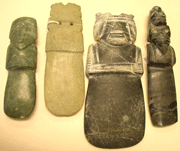
Jade ax god pendants, Costa Rica, 300 BC-500 AD, $1,200-$4,000 each
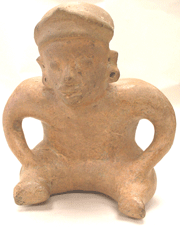
Seated red clay male figure, Colima, Mexico, 250 BC-250 AD, $1,500.
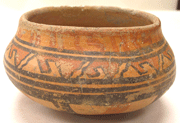
Mayan polychrome bowl, 600AD-800 AD, $400.
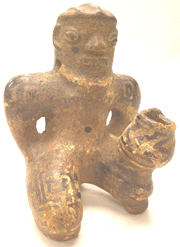
Maya pottery figure, Costa Rica, 600 AD-900 AD, $650.
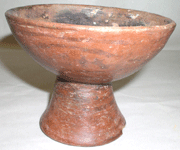
Polychrome pedestal bowl, Narino Culture, Ecuador, 800 AD-1200 AD, $500.
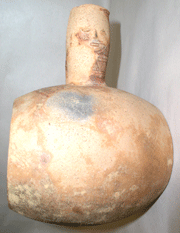
Face jug canteen, Muisca Culture, 1000 AD-1540 AD, $1,600.
|